A number of people have remarked on the fact that, although I write stories set in a lot of different places, there are more stories set in Japan or containing Japanese themes than on any other single culture. There are certainly a lot of stories set in Spain, where I grew up, and in London, where I lived for a while, and a few set in Southeast Asia, where I live now. Although I’ve traveled to Japan on several occasions, I’ve never lived there. So why are so many of my stories set there?
There is a considerable amount of psycho-sexual development theory suggesting that the sexual beings we grow up to be are, at least in part, formed by the intersection of memorable stimulus at the tender age of sexual awakening. I think I was about 9 years old when I stumbled across my parent’s book on Japanese Woodblock prints. The book, which I cannot trace back now, was a hefty coffee-table sized volume bound, seductively, in hessian-covered hardback form. It was never hidden. It sat in a carelessly shelved collection of other art books, between a large one on Francisco Goya and a general volume containing high-quality prints of the French Impressionists. And, admittedly, I did spend a lot of time with the Goya book, which may go some way to explaining why my eroticism has such a dark side, and why I’m unaccountably turned on by his iconic “Tres de Mayo“. Of course, one could easily read all sorts of deeper meanings into my erotic response, but I think the explanation is really quite simple: I was just at that age where anything of any visual weight was going to turn me on. I also get turned on by the brutality of bullfights. I’m pretty sure this is just because I got taken to so many at that age. Slowly it evolved into a rather unflattering sexual fetish for violent spectacle. But that’s for another post.
Having by far more direct influence on my early sexualization was this book of Japanese woodblock prints. Included in the book were a number (probably more than the necessary representative amount) of shunga prints. “Shunga” is the Japanese word for spring. I gather this is a nature-based allusion to the way animals seem to get frisky during that season. Shunga encompases a wide range of visually erotic material: from cheap black and white images printed on rice-paper, to lush paintings on silk. Format wise, Japanese erotic art traditionally came in a number of different formats: from horizontal scrolls, to single sheets, to pamphlets and even calendars. Shunga was produced, in some form or other in Japan, from the late 16th Century through to the late 19th Century. I think it is fair to say that, although shunga material was widely used, it was never exactly ‘proper’ material for polite company. Attempts to censor it came and went throughout those centuries, but with little effect. It wasn’t until the beginning of the 20th Century that governmental powers in Japan decided to ban it outright and impose stiff penalties on its manufacture. Sadly and ironically, this has meant that until the last decade, there has been a legal prohibition on the importation of shunga artworks back into their country of origin!
However, by far the most valued works of shunga were produced during the Edo or Tokagawa period, during the height of the Ukiyo-e. This period saw the rise of some of the most important Japanese woodblock artists. Very few of them did not, at one point or another in their lives, produce shunga. It might be hard for people in the west to comprehend, but none of these artists’ reputations ever suffered for their production of explicit erotic prints. It was, as far as I can tell, a perfectly acceptable way to supplement their income as artists.
This series of prints, Prelude to Desire, by Kitagawa Utamaro, was first produced in 1799, but was reprinted again and again through the 17th Century
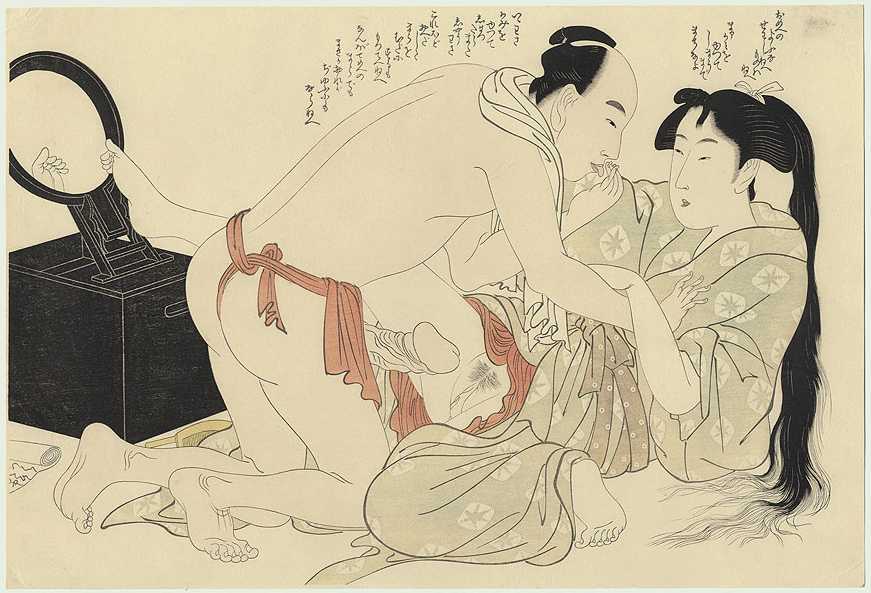
Utamaro is known for his fine keylines, his subtle colouration and his amazing detail.
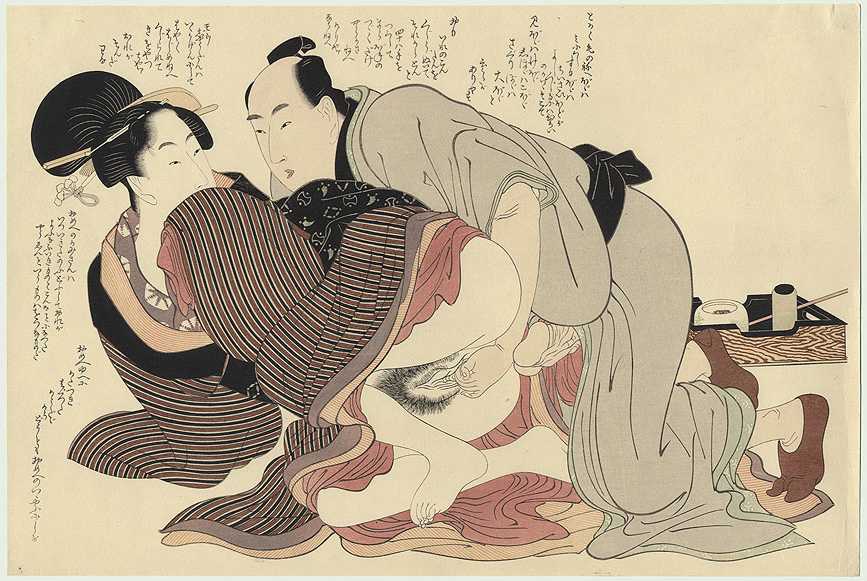
I realize it’s not easy, but if you can wrench your eyes off the enormous genitals for a minute, take a look at the beautifully detailed kimono patterns, the mirror (in the first print), and the wood-grain on the box (in the second).
Other celebrated producers of shunga came out of what is known as the Utagawa school. Established by Utagawa Toyoharu, it is by far the most famous group of woodblock artists of the 19th Century. Hiroshige, Kunisada, Kuniyoshi and Yoshitoshi were all members of the school and it is hardly surprising that they also created some of the most beautiful shunga work, as well as wealth of exquisite non-erotic prints.
Unfortunately, because the head of the school changed and Japanese artists had a tradition of changing their name to reflect the influence of their teachers, a number of the prints from this period are not traceable to a single artist.
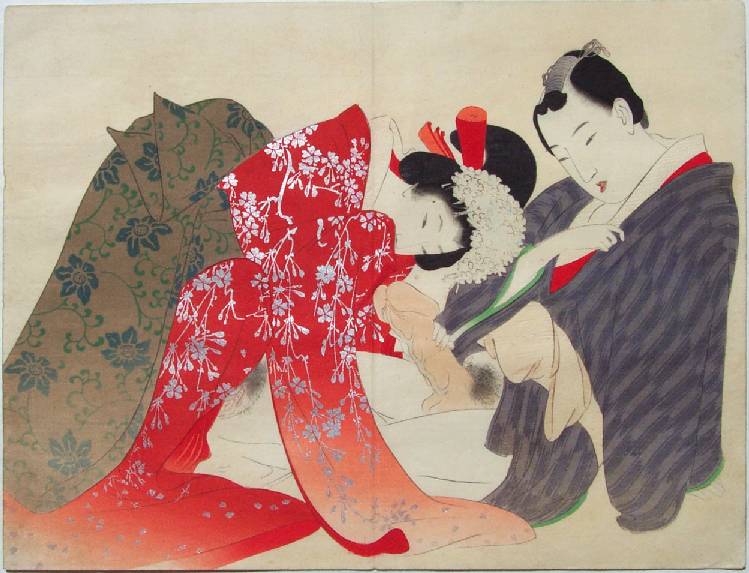
As you can see, the colours and gradiations are far richer in this print. This is partly due to the fact that woodblock printing technology simply got much more sophisticated, and also there were quality levels of shunga. From the very cheap to the extremely expensive. This particular print was produced using metallic inks to highlight the cherryblossom design on the geisha’s kimono.
Below is an example of a much lower-grade shunga in pamphlet format, by Kunisada II (i.e. a student of Kunisada who was gifted his name after the first Kunisada’s retirement)
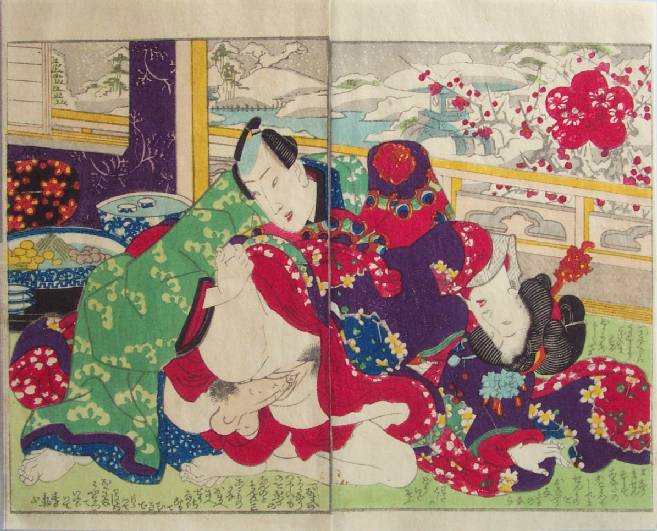
As you can see, the colours are brasher and the key-lines are not as clean. Although the scene outside in the background is quite detailed, it does not have the quality of the first three prints. Nonetheless, noteworthy in all these prints is the hallmark Utagawa school adoption of western techniques of perspective.
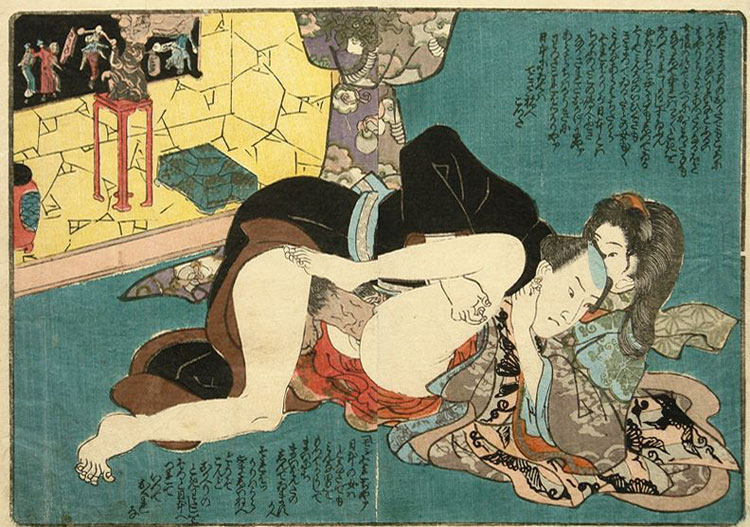
As you can see, they didn’t all get it quite right.
Although heterosexual sex predominates shunga, and images of cunnilingus or fellatio are very rare, there are some notable exceptions.
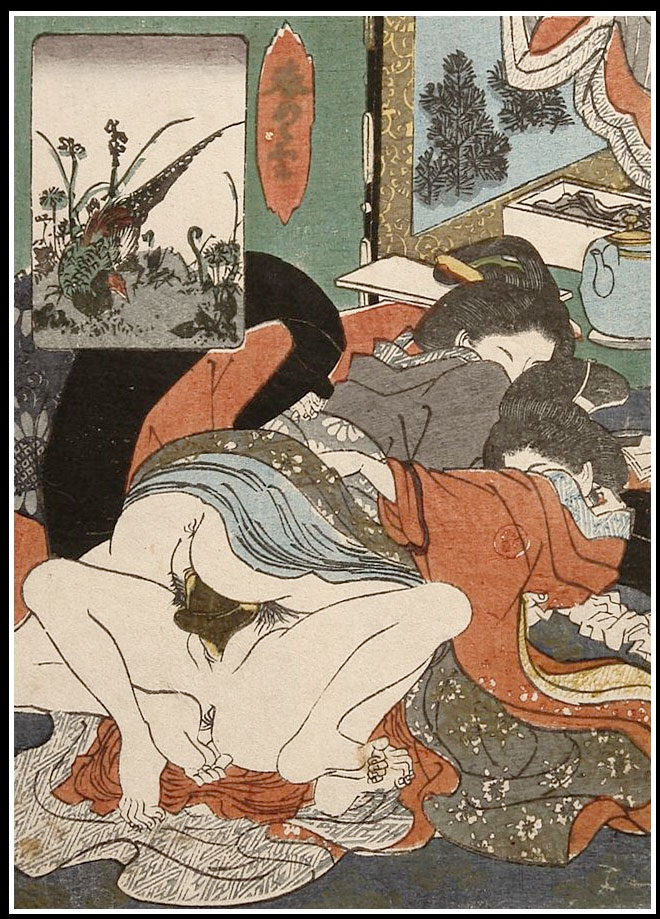
Almost all the most famous shunga artists did include lesbian scenes in their repetoires, although there is some evidence that earlier books considered them too controversial. Later editions did include them. Akantiek.com has an excellent essay on lesbian shunga here.
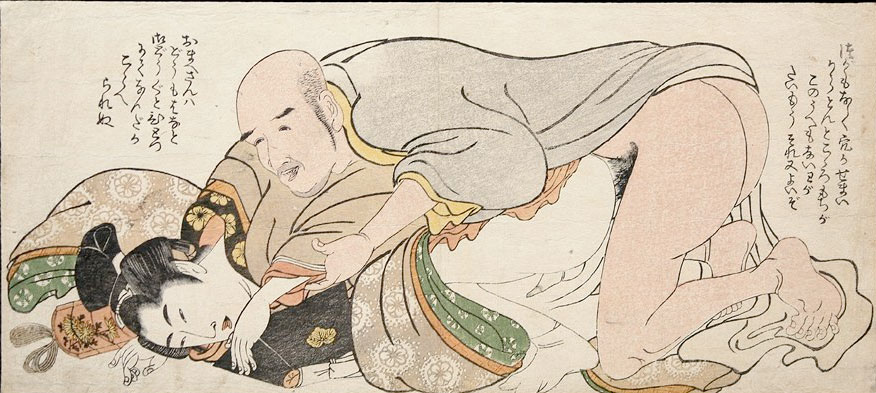
There are a number of good articles and online exhibits of gay shunga. Again, Akantiek.com has a good survey of gay shunga here. And Gay Art History.org has a nice online gallery here.
Voyeurism is a predominant theme in shunga. I haven’t really read any convincing attempts to explain why this is, but it is a significant kink that carries on into today’s Japanese porn. Singles overlook couples, people watch animals, children interrupt their parents. There is an intriguing masturbatory aspect to this type of shunga in many of its examples. I often wonder if this particular theme doesn’t hint at the viewers role in the consumption of the shunga in question. The peeking masturbator becoming the narrative companion of the shunga viewer?
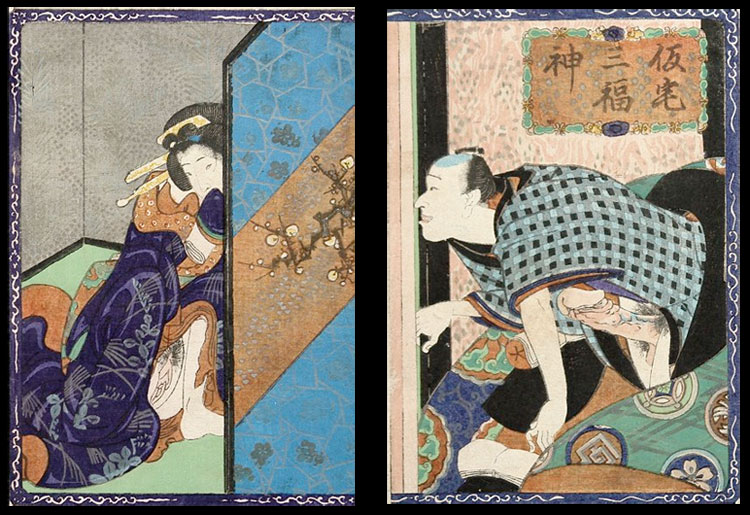
There’s even a sweet piece of shunga showing a couple fucking while a pair of mice look on, and fuck as well.
For me, shunga was my first encounter with visual eroticism. Of course, like any 9-year old, the massive size of the organs both scared and fascinated me. And for a long time, I simply assumed that the Japanese were simply very well endowed. It wasn’t until I got older that I realized the artistic strategy of the enlargement wasn’t about sexual hyperbole, but a practical matter of making the part of the picture that would turn people on easier to see.
I also credit shunga with having saved me from that awkward stage that most adolescent girls go through of thinking cocks are vaguely disgusting but unavoidable. I did have a precocious admiration for the ridges and veined texture of cocks. I had a fascination for the shape of the head and the slightly comic demand of a rampant erection.
Finally, I’m pretty sure that first encounter with Japanese erotic woodblock prints played a major role in my desire, over 30 years later, to set some of my stories in Japan.
I would like to thank a couple of sites for generously making large galleries of shunga available online, in a large enough format to really appreciate them:
- The Ukiyo-e Gallery Online has a wonderful set of prints, navigable by thumbnail.
- Akantiek.com, out of the Netherlands, also has an enormous collection with excellent research, articles and attributions.
There are also a number of marvelous books on shunga. I’ve made a Shunga Wishlist on Amazon for convenience, but please note – it’s not actually a wishlist. I already own most of these texts.

Very nicely written piece. This is very informative. Thank you.
RG,
Thank you for this, I find the Japanese culture to be very interestingly unique.
The formalities they seem to embrace is very intriguing. There is a room in my
home adorned with various things of this culture, of course there is a curved sword
on the mantle, just something about Japanese steel….
~TFP
I found your post very interesting. I grew up in the deep south. My first introduction to sexual material was the old dirty magazines that I used to find hidden in the back of my grandfather’s closet. They were marketed as “true” crime stories but they featured explicit photos of men and women in sexual situations, often with bdsm themes. There was also a collection of post cards from the 40’s that I ran across once that featured women being spanked. I think I was about 10 years old at the time. I pocketed a few of them and had them hid for years. I wish I still had them. When he passed, I went looking for the stuff but I think one of his brothers cleaned it out before I got there. I was too embarassed at that age to ask for it to be returned. Such things back then were considered shameful. I am pretty sure if they every knew I found them they would have been burned.
I spent the next 20 years fighting my own inclinations. I doubt that was the only thing that affected my taste, but I am sure it had a huge effect on my forming sexual taste. It took decades for me to become comfortable with my “darker” preferences. There is beauty in all the ways we love… Right?
K.
I think I love you. Your early exposure to Goya as a possible stimulus in the development of your sexual expression does indeed conjur questions that reach to religion, torture, dark and unimaginable demons. I, for one find nothing sexual or stimulating of basic instincts in Goya, however my exposure to his work was later in my young adulthood. I find him stimulating, yes, but not sexual. The performer Madonna seems to have a sexual attitude that lies deep in religion and I think more women than men would find Goya, the mysterys of Catholicism that by there very being, exempt women from power in the church, and womens submission and rape fantasys to begin more with an unhappy exposure to religion. As the Grand Inquistor stated, “Women by their nature are evil and must have the sins of the flesh erased.” Of course, he was an idiot.
Well, I’m pretty sure that Goya had grave quarrels with church doctrine. It’s evidenced, I think, by how many of the subjects of his work show a fascination for the darkside of spirituality. Of course, he came under the scrutiny of the Inquisitorial court himself, for his Maja Desnuda.
You have mentioned Goya before and myself, being an admirer of you both, find the connection fasinating. You may be one of the most thoughtful and intelligent people I have ever read. My love to you, your dark side, and the light that guides you.
(here’s where I remind myself that compliments should be received gracefully) Why, thank you.
My Lady
Such a great piece. Beautifully written, and it’s wonderful to get such an interesting insight into Japanese art, especially for me here in London; it’s the kind of thing where I want to discover more but lack the vocabulary and know-how to really look for it.
Also the beginning, considering images we might have seen and things we might have experienced at that age of sexual awakening is real food for thought. It’s making me want to delve back to my 9-year-old self and see what lies there. I’m sure there must be some hints at that age for most people about where their sexual proclivities come from.
Thank you so much for sharing.